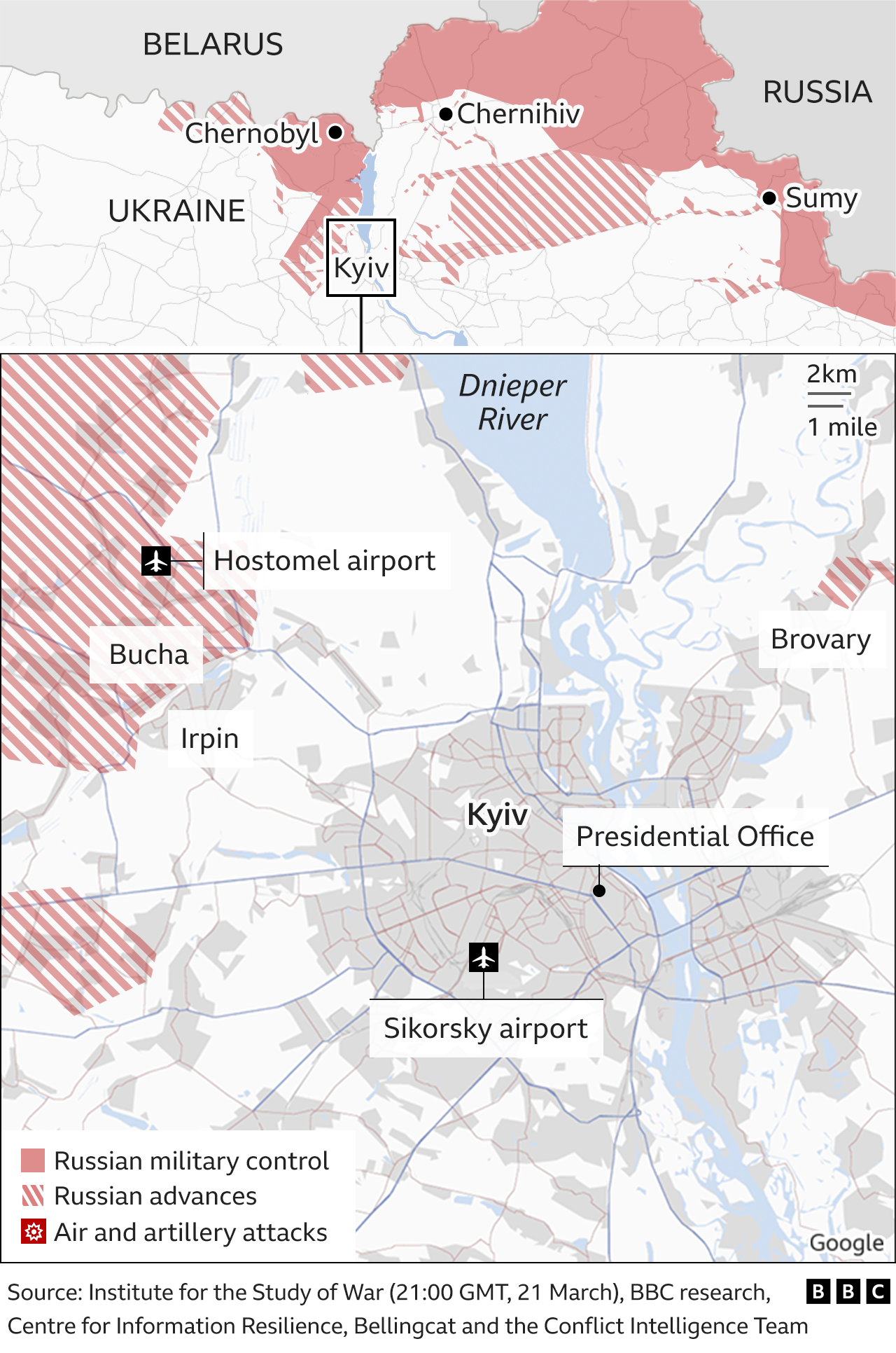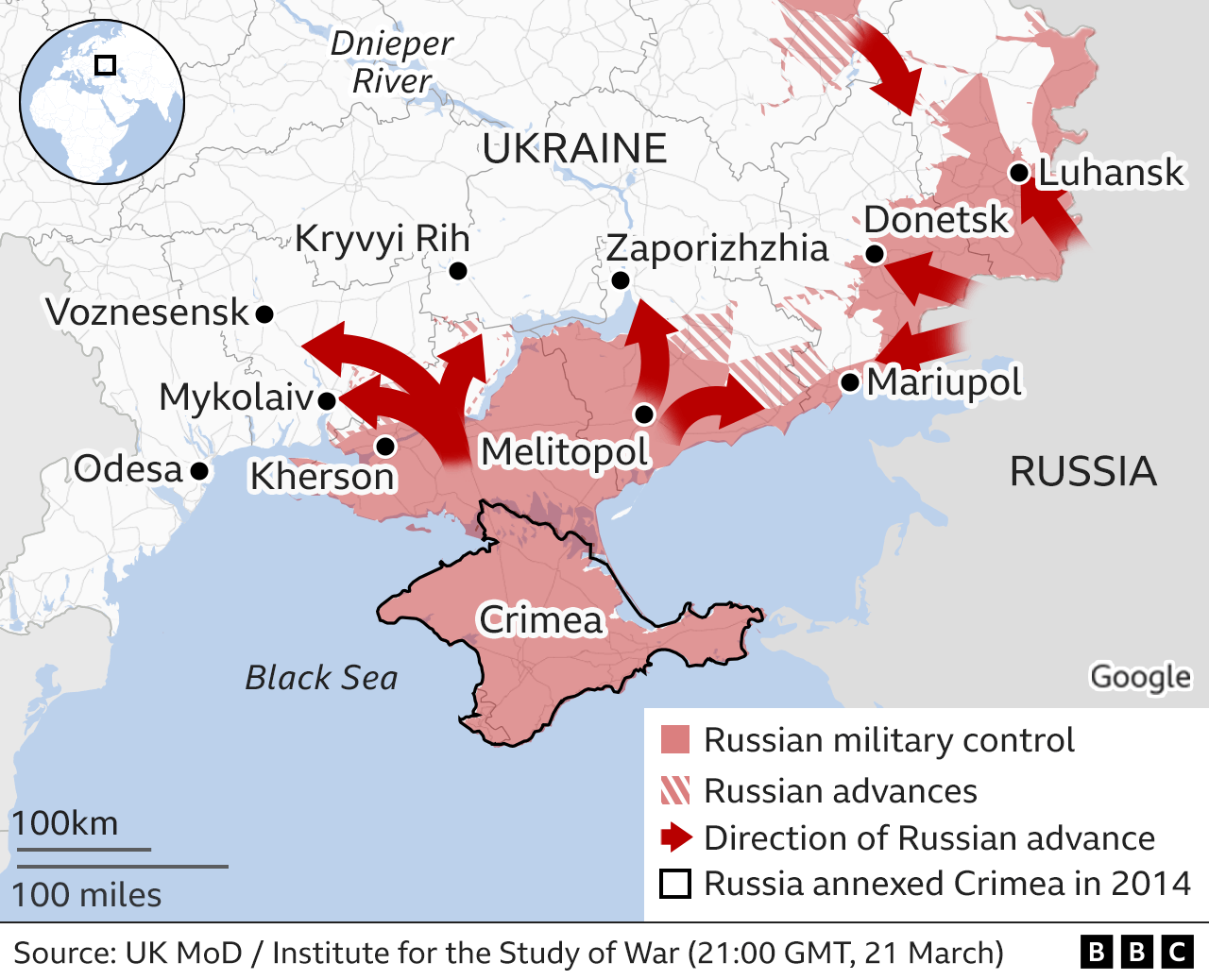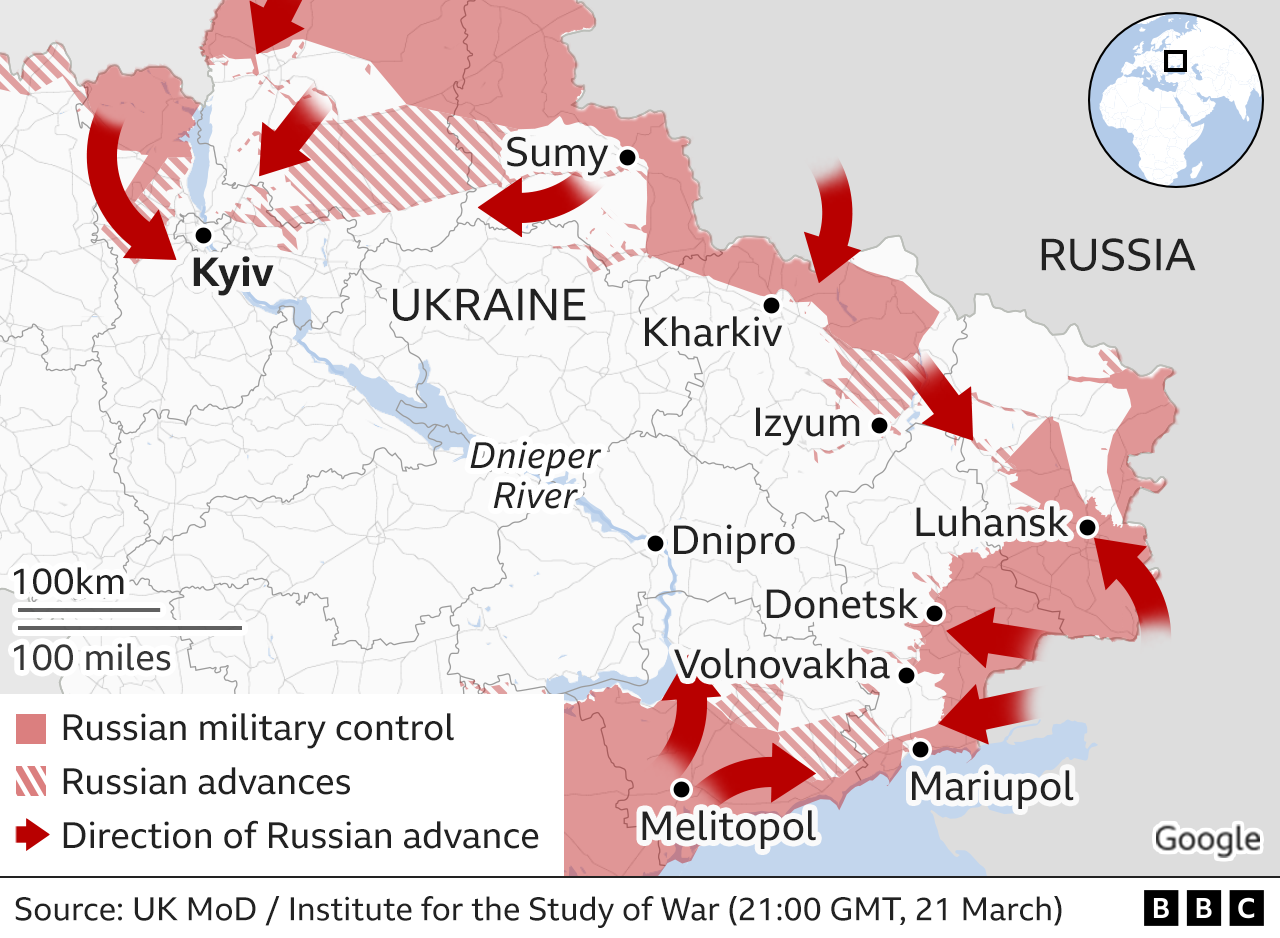BBC News 22 March 2022 - by The Virtual Journalism Team
Russian advances have ground to a halt in many areas, with Ukrainian forces holding out in several cities and also launching effective counterattacks.
Here are the latest developments on day 27 of the invasion:
- Russia continues its bombardment of several Ukrainian cities
- Russian forces continue to lay siege to the city of Mariupol in the south of Ukraine
- Russian troops and artillery remain on the outskirts of Kyiv
- Ukrainian forces still hold Kharkiv in the east
- Russian naval forces remain off the coast of Odesa in the Black Sea
Russia launched its attack in the early hours of 24 February, but more than three weeks into the war its forces have failed to build on initial gains they made across the country.
The failure of the initial campaign to seize major cities like Kyiv, Kharkiv and Odesa could result in a "very violent and bloody" stalemate that could last for weeks or months, warns the Institute for the Study of War (ISW).
The ferocity of the Ukrainian resistance has meant Russian forces have been forced to change their approach, according to the UK Ministry of Defence (MoD).
They are now pursuing a "strategy of attrition" which could result in increased civilian casualties and greater destruction of cities in the coming days, assessed the MoD.
The fight for Kyiv in the north
Russian forces have been attempting to encircle and cut off the capital, but large areas around Kyiv remain under Ukrainian control, especially in the south.
Ukrainian generals in Kyiv have said their focus at the moment is on keeping Russian artillery out of range of the city centre, but shelling continues to cause casualties and destroy homes.
Russian troops advancing on the capital have faced strong Ukrainian resistance and also had serious logistical problems, with many vehicles running out of fuel.
The closest Russian troops to the north west of Kyiv are in the suburbs of Bucha and Irpin, about 25km (15 miles) from the city centre, but they have failed to cross the Irpin River so far.
That river and others across the city, as well as difficult terrain like marshlands and bogs, have helped Ukrainian forces slow Russian advances so far.
The mayor of Boryspil, around 15km (10 miles) south-east of Kyiv and home to the largest international airport serving the capital, has advised civilians to leave as fighting between advancing Russians and Ukrainian forces is now close by.
A Russian advance from the east has stalled around the suburb of Brovary, about 20km (12 miles) away from the centre of Kyiv. Taking the suburb would bring the Russian howitzer guns within range of the city centre.
War in Ukraine: More coverage
Big Russian gains in the south
Russian forces initially made rapid gains in the south, with their main objective being the creation of a land corridor between Crimea, which it annexed in 2014, and areas held by Russian-backed separatists in Donetsk and Luhansk.
Standing in the way of that objective has been the port city of Mariupol, which has been encircled by Russian forces since the start of March. Ukrainian officials say some 300,000 civilians remain trapped in the city.
On Monday morning, the government in Ukraine rejected a Russian demand to surrender Mariupol. The Russian military had given Ukraine until 05:00 Moscow time (02:00 GMT) to announce the city's surrender, promising that in return it would would safeguard two humanitarian corridors for civilians to leave the city.
Previous attempts to create safe corridors out of the city for civilians through ceasefires have collapsed, with those fleeing coming under fire.
Elsewhere in the south, Russian forces appear to be focusing on a drive toward Kryvyi Rih, possibly with the aim of isolating and taking Zaporizhiya and Dnipro from the west, ISW analysts suggest.
Russian advances on Mykolaiv in the west have slowed, although missile strikes have targeted Ukrainian positions. Ukrainian forces have launched a number of counterattacks against Russian positions near the city.
Taking Mykolaiv is key for the Russians to push further west towards Odesa and cut off Ukraine's access to the Black Sea.
Russian naval forces off the coast of Odesa have conducted some shelling of the city in recent days but an amphibious landing would be very difficult and a sign of Russian desperation, according to Mr Bronk.
Russian advances in the east
Fighting continues in the Donetsk and Luhansk regions, where Russian-backed separatists held significant territory before the Russian invasion.
In the north east, Russian troops have almost surrounded the city of Sumy, but Ukrainian forces have prevented attempts to cut it off from the south.
A similar attempt to encircle Kharkiv, Ukraine's second-largest city, has also been repelled with analysts saying Russian forces there are in short supply of ammunition.
The BBC's Quentin Sommerville, who has been in Kharkiv this week, says Russians forces there have grown frustrated at not being able to take the city and have turned to artillery strikes instead, destroying entire neighbourhoods.
By David Brown, Bella Hurrell, Dominic Bailey, Mike Hills, Lucy Rodgers, Paul Sargeant, Mark Bryson, Zoe Bartholomew, Sean Willmott, Sana Dionysiou, Joy Roxas, Gerry Fletcher, Jana Tauschinsk and Prina Shah.
About these maps
To indicate which parts of Ukraine are under control by Russian troops we are using daily assessments published by the Institute for the Study of War with the American Enterprise Institute's Critical Threats Project.
From 2 March this daily assessment differentiated between "Assessed Russian-controlled Ukrainian territory" and "Assessed Russian advances in Ukraine", the latter indicating areas where Russians are believed to have launched attacks from but which they do not control.
To show key areas where advances are taking place we are also using daily updates from the UK Ministry of Defence and BBC research.
The situation in Ukraine is fast moving and it is likely there will be times when there have been changes not reflected in the maps.






